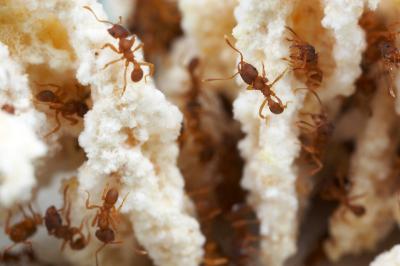The Brazilian and Texas researchers confirmed that the ants planted Mycocepurus smithii, the only species in the world that includes only females and reproduce completely asexually.
Most social insects such as termites, ants, and bees are familiar with the absence of male animals in daily life activities. These insect flocks are maintained by the ant-breeding ants under the command of an egg-laying princess. But, in general, all social insects have the ability to produce male individuals, these individuals continue to travel around to perform breeding functions by fertilizing the gods.
However, according to reports of Christian Rabeling and Ulrich Mueller and colleagues in the recent PloS ONE, the queen in the species Mycocepurus smithii reproduces without conception and in the herd does not have any male presence. Come on.
'Completely asexual reproductive animals are rare in nature, and this makes the difference of the ants we studied,' Rabeling, a researcher specializing in ecology, evolution and onions. vi, said. 'In the long term, asexual reproductive species do not recombine genes in their offspring, so harmful mutations are likely to accumulate over time and make them face the risk of extinction more quickly. other species. In general they are incapable of sustaining the breed for a long time through evolution. '
Previous studies of Mycocepurus smithii ants in Puerto Rico and Panama have suggested that it is very likely that this species reproduces completely asexually. Specifically, the study conducted by Mueller and Anna Himler showed that queen of this species reproduces in the laboratory without the need for fertilization of male ants.
 Mycocepurus smithii ants are taking care of their mushroom gardens. These are the only known asexual ants in the world. (Photo: © Alex Wild)
Mycocepurus smithii ants are taking care of their mushroom gardens. These are the only known asexual ants in the world. (Photo: © Alex Wild)
However, in 1960 scientists found males of M. smithii in Brazil.If there are really male individuals in existence, then surely - at least sometimes - this ant species also reproduces sexually.
Rabeling analyzed these male suspects and discovered that they belonged to another species with a close relative of M. smithii, which is called Mycocepurus obsoletus and reproduces sexually.Therefore, he and his research team confirmed that the search for Mycocepurus smithii does not exist in the male population.
He also performed anatomy of the M. smithii ants from Brazil and discovered that their sperm-containing organs were completely empty.
Combined with previous studies, Rabeling and her colleagues came to the conclusion that Mycocepurus smithii is a completely asexual species, from herds living in Northern Mexico to herds in Central America or Brazil.
In the history of evolution, scientists estimated that this ant species began to appear on Earth 1 to 2 million years ago.Thus, this is a young species compared to the 50 million year development history of the group of ants growing mushrooms.
Rabeling says he is using genetic markers to study the evolution and subspecies of fungal ants, which will help determine the exact time of birth and the genetic mechanism of asexual reproduction in the future.
 Why do potatoes have eyes?
Why do potatoes have eyes? 'Tragedy' the world's largest carnivorous life: Death becomes ... public toilet
'Tragedy' the world's largest carnivorous life: Death becomes ... public toilet Tomatoes were once considered 'poisonous' for 200 years
Tomatoes were once considered 'poisonous' for 200 years Detecting microscopic parasites on human face
Detecting microscopic parasites on human face Strange species in Southeast Asia becomes the first marine fish species 'extinct due to humans'
Strange species in Southeast Asia becomes the first marine fish species 'extinct due to humans'  Ancient humans may still live on Indonesia's Flores island
Ancient humans may still live on Indonesia's Flores island  The 'dragon' species that was thought to only exist in myths is one of the rarest on the planet.
The 'dragon' species that was thought to only exist in myths is one of the rarest on the planet.  How many animals have ever existed on Earth?
How many animals have ever existed on Earth?  Treasure of Southeast Asia: Rare animal species found in only 9 countries in the world, Vietnam just received good news!
Treasure of Southeast Asia: Rare animal species found in only 9 countries in the world, Vietnam just received good news!  'Ghost humans' discovered leaving 'hybrid offspring' in 3 modern countries
'Ghost humans' discovered leaving 'hybrid offspring' in 3 modern countries 